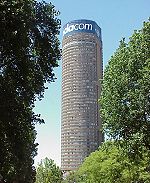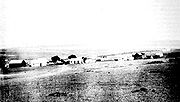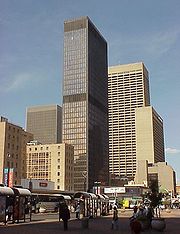|
|
 |
d |
 |
|
| |
| |
| |
 |
About Johannesburg |
|
|
| |
Johannesburg (Afrikaans pronunciation: [jo'h?n?s?b?rx]) also known as Jozi or Jo'burg, is the largest city in South Africa. Johannesburg is the provincial capital of Gauteng, the wealthiest province in South Africa, having the largest economy of any metropolitan region in Sub-Saharan Africa. The city is one of the 40 largest metropolitan areas in the world[5] and it is one of Africa's only three global cities, the other two being Cairo and Cape Town.[6]. While Johannesburg is not officially one of South Africa's three capital cities, it does house the Constitutional Court – South Africa's highest court.
Johannesburg is the source of a large-scale gold and diamond trade, due to its location on the mineral-rich Witwatersrand range of hills. Johannesburg is served by O.R. Tambo International Airport, the largest and busiest airport in Africa and a gateway for international air travel to and from the rest of southern Africa.
According to the 2007 Community Survey, the population of the municipal city[clarification needed] was 3,888,180 and the population of the Greater Johannesburg Metropolitan Area was 7,151,447[citation needed]. A broader definition of the Johannesburg metropolitan area, including the Ekhuruleni, the West Rand, Soweto and Lenasia, has a population of 10,267,700[citation needed]. The municipal city's land area of 1,645 km2 (635 sq mi) is very large when compared to other cities, resulting in a moderate population density of 2,364 /km2 (6,120 /sq mi).
Johannesburg once again includes Soweto, which was a separate city from the late 1970s until the 1990s. Originally an acronym for "SOuth-WEstern TOwnships", Soweto originated as a collection of settlements on the outskirts of Johannesburg populated mostly by native African workers in the gold mining industry. Eventually incorporated into Johannesburg, the apartheid regime (in power 1949 - 1994) separated Soweto from the rest of Johannesburg to make it a completely Black area. Lenasia is also part of Johannesburg.
Gauteng is growing rapidly due to mass urbanisation which is a feature of many developing countries. According to the State of the Cities Report, the urban portion of Gauteng – comprised primarily of the cities of Johannesburg, Ekurhuleni (the East Rand) and Tshwane (greater Pretoria) – will be a polycentric urban region with a projected population of some 14.6 million people by 2015.[7] |
 |
|
| |
History
The region surrounding Johannesburg was originally inhabited by San tribes. By the 1200s, groups of Bantu-speaking peoples started moving southwards from central Africa and encroached on the indigenous San population. By the mid 1700s, the broader region was densely settled by various Sotho-Tswana communities (one linguistic branch of Bantu-speakers), whose villages, towns, chiefdoms and kingdoms stretched from what is now Botswana in the west, to present day Lesotho in the south, to the present day Pedi areas of the northern Transvaal.
More specifically, the stone-walled ruins of Sotho-Tswana towns and villages are scattered around the parts of the former Transvaal in which Johannesburg is situated. The Sotho-Tswana practiced farming, raised cattle, sheep and goats, and extensively mined and smelted copper, iron and tin. Moreover, from the early 1960s until his retirement, Professor Revil Mason, of the University of the Witwatersrand, explored and documented many Late Iron Age archeological sites throughout the Johannesburg area, dating from between the 1100s and 1700s, and many of these sites contained the ruins of Sotho-Tswana mines and iron smelting furnaces, suggesting that the area was being exploited for its mineral wealth before the arrival of Europeans or the discovery of gold.[citation needed] The most prominent site within Johannesburg is Melville Koppies, which contains an iron smelting furnace. Many Sotho-Tswana towns and villages in the areas around Johannesburg were destroyed and their people driven away during the wars emanating from Zululand during the late 1700s and early 1800s (the mfecane or difaqane wars), and as a result, an offshoot of the Zulu kingdom, the Matabele, set up a kingdom to the northwest of Johannesburg around modern day Hartebeestpoort and Rustenburg, and historians believe that the Matebele kingdom dominated the Johannesburg area.[citation needed] The Dutch speaking Voortrekkers arrived in the early 1800s, driving away the Matebele with the help of Sotho-Tswana allies, establishing settlements around Rustenburg and Pretoria in the early 1830s, and claiming sovereignty over what would become Johannesburg as part of the South African Republic or Transvaal Republic. Gold was discovered in the 1880s and triggered the gold rush. Gold was initially discovered some 400 km to the east of present-day Johannesburg, in Barberton. Gold prospectors soon discovered that there were even richer gold reefs in the Witwatersrand. Gold was discovered at Langlaagte, Johannesburg in 1886. |
 |
|
| |
Government
During the apartheid era, Johannesburg was divided into 11 local authorities, seven of which were white and four black or coloured. The white authorities were 90% self-sufficient from property tax and other local taxes, and spent ZAR 600 (USD 93) per person, while the black authorities were only 10% self-sufficient, spending R 100 (USD 15) per person.[citation needed] The first post-apartheid City Council was created in 1995. The council adopted the slogan "One City, One Taxpayer" in order to highlight its primary goal of addressing unequal tax revenue distribution. To this end, revenue from wealthy, traditionally white areas would help pay for services needed in poorer, black areas. The City Council was divided into four regions, each with a substantially autonomous local regional authority that was to be overseen by a central metropolitan council. Furthermore, the municipal boundaries were expanded to include wealthy satellite towns like Sandton and Randburg, poorer neighbouring townships such as Soweto and Alexandra, and informal settlements like Orange Farm. In 1999, Johannesburg appointed a city manager in order to reshape the city's ailing financial situation.[citation needed] The manager, together with the Municipal Council, drew up a blueprint called "Igoli 2002". This was a three-year plan that called upon the government to sell non-core assets, restructure certain utilities, and required that all others become self-sufficient. The plan took the city from near insolvency to an operating surplus of R 153 million (USD 23.6 million).[citation needed] Following the creation of the City of Johannesburg Metropolitan Municipality, Johannesburg was divided into eleven administrative regions (these regions did not correspond to the areas governed by the former local authorities). In 2006, the number of administrative regions was consolidated, from eleven to seven.[4] |
 |
|
| |
|
| |
|
|
|
|
|
|
|
| |
|